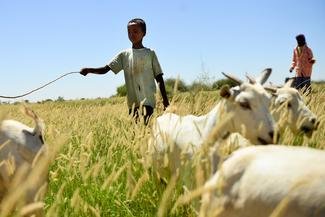
Gudrun Weßling-Hunder, Jutta Maat, Frans Maat, Ursula Kopetzki, Ingrid Nowotny, Sabine Metin, Theo Drees and Bettina Sahlmann (from left)
On Sunday, November 10th, took place in the church on Billebrinkhöhe Fair trade worship on the subject of “child labor" instead of. The service, which was prepared by the One World Team at Billebrinkhöhe together with Pastor Gudrun Weßling-Hunder, made it clear how many children in developing countries have to make their daily contribution to family income and how big the income differences are between the rich industrialized nations and the poor countries.
Frans Maat introduced the topic by pointing out that 215 million children between the ages of five and 17 have to work to feed their families. For every second child, this achievement is dangerous to health. About that in addition, they often only receive starvation wages for this hard work. A school visit is unthinkable in this life context. The causes of child labor are complex: in addition to poverty, social structures such as the caste system in India and economic potential are just a few of the causes.
Unesco has statistics, which show that the 1.2 billion people in rich countries have an average annual income of $ 28,550, while the 5.3 million people in emerging markets have to make do with an average of $ 1,920. In poor countries, people only have an average of $ 450 at their disposal. That’s just $ 1.25 a day. For many, that’s not enough to survive. Nine million people die of hunger each year, including five million children. Frans Maat: "Somewhere in the world, a child under the age of ten dies every five seconds."
The people of the rich countries make up only 20 percent of the world’s population, but use 85 percent of the raw materials, such as corn, grain, rice, oil, gas and water. The rich countries live in a disposable system. Experts estimate that up to 40 percent of the raw materials produced are destroyed, not just packaging, but also excess food, furniture and much more. In theory, this earth could feed twelve billion people, significantly more than the current 7.2 billion. To do this, however, much of the behavior of people in rich countries would have to change.
The basic question is: What contribution can we make so that the social and economic conditions for children in the respective countries change in the long term and sustainably?
Jutta Maat, Ingrid Nowotny and Ursula Kopetzki subsequently reported on three exemplary children’s fates:

1. The eleven year old Suma lives in Jharia in India. She is a coal collector and collects leftover pieces of coal every day on the city’s coal dumps with her younger sister. She carries the heavy baskets of coal with them on her head, where the coal is crushed with an iron hammer so that it can be sold on the market.
2. The eleven year old Alfonso works in a clay mill and brick factory in Lima in Peru. He uses a hoe to cut thick patties, press them into heavy wooden molds and then tip them over with his younger one Brothers around. The stones then dry. The smaller siblings up to the age of four turn the bricks, the older ones bring them to the brick factory. They suffer early from back problems, diarrhea and typhoid from dirty water.
3. The twelve year old José lives in Brazil. He works in the sugar cane fields, where he hits and bundles the sugar cane. For six working days of twelve hours each, he gets 15-23 euros. He can’t go to school. His tools are a pair of raven black, punctured gloves and a machete
The worship service went to the Family-Posielek Foundation, who supports street children in India. A child can go to school there for 10 euros a month, and can go to high school or even study for 20 euros. The foundation works quickly and directly and guarantees that 100% of all donations go to the projects, because the employees work on a voluntary basis and without any expenses. It also controls how and where the donations are used.
We can also make our own contribution by buying fair trade products in world shops or products with a Transfair seal in the supermarket. There is also the possibility of writing letters to politicians or textile company owners so that the problems in developing countries become more focused.

After the service there was an opportunity to get one Unicef exhibition to look at child labor and buy products at the One World booth. Many thanks to the preparation team (Jutta Maat, Frans Maat, Bettina Sahlmann, Theo Drees, Ursula Kopetzki, Ingrid Nowotny, Sabine Metin, Gudrun Weßling-Hunder) for the intensive, stimulating service!
RELATED ITEMS
-

Working for a few cents: child labor in Asia, all multimedia content of the German wave, dw
They work in agriculture, in mines, factories or in service: According to estimates by the International Labor Organization ILO are worldwide…
-

Child labor worldwide, world vision germany
On this page we give you an overview of the most important information about child labor and approaches of World Vision…
-

Child labor – when being a child fails in everyday life
BY JASCHA SCHULZ | 2015-10-29 18:44 Child labor – When being a child fails in everyday life In recent years, the number of working children…
-

Companies benefit from the suffering of many children The unscrupulous business with child labor. There are frustrating numbers that the international…
